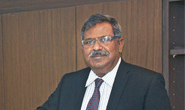Today, 70 per cent of our GDP comes from urban areas while the investment for urban development is only 0.70 per cent. Now, according to the McKinsey Global Institute (MGI) report, Indias urban population is projected to increase from 34 crore in 2008 to 59 crore in 2030
FlashNews:
PIDG Expands India Portfolio, Mobilises ₹29 Billion for Sustainable Infrastructure
Anant Goenka Takes Charge as FICCI President; Centenary Logo Unveiled by Piyush Goyal
InfraPandit Awards 2025 Spotlight Doctoral Research Driving India’s Infrastructure Future
India Eyes US Trade Framework Deal by Year-End; FDI Strategy Expands Beyond Market Access
Centre Weighs Infra Status for Hotels to Unlock Tourism Investment: Shekhawat
India’s GDP Surges 8% in H1 FY26, Driven by Infra and Services
SIA‑India Pushes Bold Budget, Hybrid PLI to Power Space Sector Takeoff
South Asia Must Scale Hydro, Storage and Power Trading for Grid Integration: CEA Chief
India Can Save $204 Billion in Infra Pipeline with Better DPR Planning: Vector Consulting
Prime Minister Modi Inaugurates Skyroot’s Rocket Factory; Company Targets $21 Billion Launch Market
IWAI Signs ₹13.5 Billion MoUs to Boost Ganga Waterway in Uttar Pradesh
MOVIN Launches Healthcare Logistics Vertical to Tap India’s $638 Billion Industry
Atlanta Electricals Secures ₹2.98 Billion Transformer Orders from GETCO
Waaree Group Wins 10 MWh BESS Order in Tamil Nadu, Expands Domestic Storage Manufacturing
Cabinet Approves ₹27.8 Billion Rail Multitracking to Boost Gujarat and Maharashtra Connectivity
BC Jindal Group Secures 150 MW RTC Power Deal with SECI
India’s Data Centre Revenue to Hit ₹200 Billion By FY2028, Driven by AI, Cloud and 5G: Crisil Ratings
Sanchar Saathi Recovers 50,000 Phones in October; Crosses 700,000 Nationwide Since Launch
Akasa Air Expands Northeast Connectivity, Adds Dibrugarh as 32nd Destination
Doing more with less
Smart cities will encourage sustainable development. They will also help to optimise resources, to meet the demands of growing urban populations. These cities would also encourage usage of shared services among different utility functions.
Geosynthetics lowers carbon footprint
Dr K Rajagopal, a Professor of Civil Engineering at IIT Madras, has worked in several geosynthetics industries in India, and is an active member of the International Geosynthetics Society.
Concrete Plan!
The Modi Governments initiative to build all new highways using concrete in place of bitumen, has brought cheer to road sector experts as well as the cement industry. But contractors are worried about their future business prospects.
Geosynthetics on the move
The use of geosynthetics decreases initial construction cost and maintenance cost, increases the life and strength of the roads, which in turn decreases traffic congestion & saves fuel and reduces the carbon footprint.
Global pension funds have both liquidity and appetite for long-term investments
In a freewheeling conversation, Moses Harding, Group CEO and Chief Economist, Srei Infrastructure Finance Limited, says that he is bullish over the prospects of the infrastructure finance sector.
India International Road and Transportation Fair (IIRTF)
Transport being the most important and complex subject in the modern world where safe, quick and cost effective movement of men, machines and materials, is the objective of all governments and businesses.
World-leading Compactors
The 11T Single Drum Soil Compactor VM115 is a globally acclaimed machine designed to offer high compaction and greater output at the lowest fuel consumption within the category of machines
Dynamic Professional
Sanjay Singh is Director- Human Resources and Administration at Cairn India. In his current role, Singh is responsible for creation and delivery of dynamic HR strategies to meet the business needs of the organisation.
Global View
Ramesh Nair, COO - Business & International Director, JLL India has been appointed to the Global Regulatory Board of RICS, becoming the first Asian to take on this role.









